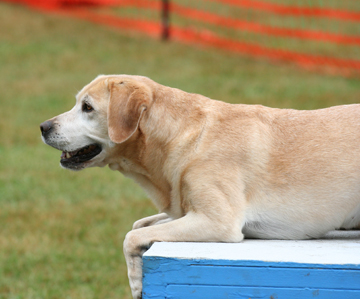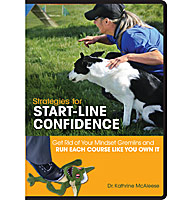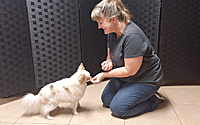 Championships Three Ways (or More)
Championships Three Ways (or More)
By Brenna Fender
Many competitors start their agility careers dreaming of finishing a championship with their dogs. The goal seems almost unobtainable to some, but over time, it may become within reach. Earning an agility championship may finish up a dog’s career, but it also could be part of a path toward multiple championships within the same organization, building on excellence and pursuing rankings, national championships, and so on.
Some handlers don’t just build “up” on their championships—they build “out.” They finish championships in numerous organizations, mastering the challenges of each distinct flavor of agility. Reaching the top of multiple registries entails becoming proficient at distance work while also being able to handle close and tight sequences, running with great speed while also being very consistent, jumping different heights and widths, climbing different-sized contacts with varied surfaces, and in some cases, training entirely new obstacles.
You would think that accomplishing so many different skill sets and finding the time to attend enough trials to go from novice to champion in multiple venues would take significant planning and a lot of cash. Not so, say the multiple-championship handlers we asked. Succeeding on such a grand scale seems to come more out of a general love for the sport—and for a good challenge—than any pre-planned strategy. And the costs aren’t any more than those of trialing in the same venue, assuming that you intend to compete the same number of weekends each year. “It really is not more expensive, since you can only enter one show per weekend,” says Ileana Nadal, who has completed multiple championships on several different dogs, including Boxers and a Cavalier King Charles Spaniel.
Still, competing in more than one agility registry, and doing so at the highest levels, does take dedication and good training skills. Training and trialing in multiple venues takes ability and effort, and can be easier for dogs and handlers with particular personalities, body types, and other characteristics.
Training for Multiples
Does training to compete in the upper levels of many different agility organizations require a lot more training time and effort? It depends on how you train. “Mostly I train the same for all organizations. Cross training encourages skills that are useful in other venues,” says Ohio resident Margaret Hendershot, who, with her Jack Russell Terrier, Luigi, has earned championships in the United States Dog Agility Association, Canine Performance Events, and Teacup Dog Agility Association. Kelli Hayes, owner of multiple-agility championship winning Australian Shepherds Max and Tad, says that she trains distance for work at the beginning of each dog’s career rather than waiting for later when she competes in an organization’s events that require it. So her “game plan” doesn’t vary based on training for multiple championships: “I am constantly training to be a better handler for my dogs, but not for different venues,” she says.
Indeed, most skills required at the upper levels of each registry have applications in all venues. The well-rounded dog offers his handler a toolbox filled with trained behaviors that can be used to tackle almost any challenge. But those focused on competing in just one venue may be able to get by with fewer skills, and therefore less training time, if they choose.
One of the tricks for training for different organizations seems to be knowing what skills you need to focus on prior to competing in a particular organization’s trials. “The upcoming venue usually dictates the training I do the week or sometimes two weeks before the trial,” says Marie Logue, whose Cavalier, Winston, has earned multiple American Kennel Club Master Agility Champion titles (MACHs), a United States Agility Association Agility Dog Champion title (ADCH), and the United Kennel Club Agility Champion Excellent title (UACHX).
Some challenges seem to show up frequently at an organization’s trials, and those may be on your “to practice” list right before a competition. “NADAC [the North American Dog Agility Council] is definitely a distance-based venue,” says Californian Debby Wheeler, whose Italian Greyhound, Marti, has earned championships in NADAC, AKC, and USDAA. She continues, “So when working on NADAC training, we set wide open courses and worked on flow and speed. But, since NADAC is known for its discriminations (contact and tunnel scenarios), I definitely worked on that skill quite a bit.”
Training for Gamblers is a focus for many who have a USDAA trial ahead. Logue says, “A lot of specialized training was required for Winston to be able to do the gambles.” In Gamblers, a class in which the handler must, during one portion of the run, stay a certain distance away from the dog while the dog negotiates a section of the course, is one area that handlers focusing on only certain organization’s championships—like AKC—might skip. But distance work is a big focus in NADAC, USDAA, and Australian Shepherd Club of America (ASCA) trials. “You will have to train distance if the registry requires Gamblers,” says Pam Olsen, owner of Australian Shepherd Razz, who has earned championships in four different registries.
For some venues, it helps to brush up on tight work: “In AKC, I train for twisty courses,” says Nadal. Donna D’Amico did the same for her Shetland Sheepdog, who has an AKC MACH along with championships from other venues. “We focused on… tighter turns and so on for AKC,” she says. Kelly McFaul-Solem, who has earned championships in six different venues with her amazing and agility-record-breaking Pug, Shaili, also varies her close-up and distance work: “If I could get some practice in before a trial, I would work tighter for TDAA, AKC, and USDAA trials and focus a bit more on distance for CPE and NADAC.”
Varying heights between agility organizations are also added challenges. “I routinely trained Winston at 12" jump height and a week before USDAA trials, trained using 16" jumps,” says Logue. Floridian Victoria MacVicar, whose Brittany, Kaze, has earned agility championships in five different organizations, also pays attention to jump heights: “Heights are different in agility organizations, so I need to be sure my dogs are able to adapt their jumping from 14" to 22".”
Handlers may need to train themselves differently for each organization as well. “Read and understand the rules of the venues you are competing in,” says Logue. Nadal suggests reviewing the rules for an organization’s trials just before competing. Hendershot adds, “Handlers also have to be able to learn… how the same game may differ in two or more organizations and apply the right rules.” Keeping up with rule changes in all registries is very important as well. “I wasn’t smart enough to hit all of the NADAC/ASCA dual sanctioned trials before they separated. In the end, I needed legs in both registries in order to get Razz’s championships after they split,” says Olsen. Paying closer attention to the rule changes that announced the upcoming split would have allowed Olsen to focus on NADAC/ASCA combined trials while they lasted instead of finishing a championship in another venue.
Trialing Plans
You might think it would take lots of planning to plot a path to championships in various organizations. But many competitors who achieve these levels of greatness do so simply by trialing as often as they can afford as close to their homes as possible. “I took whatever venue was closest to home. But when a championship was close, I certainly would plan on entering a trial for that venue rather than staying local,” says Wheeler. Even those who plan ahead often just “go with the flow.” “Usually I set out goals for the year as to titles I would like to finish. Mostly, though, I just go to whatever trials are close by. Sometimes I’ll pick a show because I really like a club or judge or because the entry fee was a great deal. Mostly I just try to balance my entries between the venues and have fun,” says Hendershot.
Some handlers have detailed plans for completing multiple championships, but not necessarily because it’s easier or more cost efficient. “I like to start my dogs in ASCA and NADAC because training in the ring is allowed. This gives me a chance to train start line stays and contacts in an environment that is very positive. There are multiple runs a day in these venues and I can accomplish a lot of training,” says Hayes. “By the time both Tad and Max finished their ATCH and NATCH, I felt much more comfortable with them in the ring,” she adds. She then moved on to focusing on other organizations. Nadal has a similar approach. She says, “When you are bringing out a new dog, or resolving an issue with a dog having problems, it’s beneficial to do multiple venues to get them working happily with little stress. For example, with Tia, I did NADAC first, then USDAA, because she was too young to handle the tight AKC courses safely. With my new Cavalier, Rocket, I will start with CPE, because in the Level 1 classes, he will not encounter weaves or the teeter.” Nadals methods seem to have worked for Tia—she’s the first Boxer to earn championships in five different agility registries.
Other handlers rotate the organizations they compete in because they like variety, or because it’s easier on the dog. “Tia burns out on too many AKC trials, so I try to do NADAC and CPE in between the AKC trials,” says Nadal. Some dogs do better with consistency, so their handlers focus on one or two organizations at a time. “I found that because of the different challenges required in the various venues that we sometimes had a bit of trouble transitioning from one venue to the next, week in and week out and that our qualifying rate was higher if we ran in the same venue for several trials in a row,” says D’Amico.
Sometimes trialing plans have nothing to do with the dog. “If I concentrated too long or hard on one organization, I sometimes got frustrated and lost sight of the real reason for doing agility. Whenever I started feeling like that, I would be sure to mix it up a bit,” says McFaul-Solem. “When we were trying for the MACH, it was clear that I was getting way too stressed about it and it really helped to go play elsewhere for a few weekends,” she adds. Also, in some areas, certain flavors of agility are offered commonly and some are rare. That means planning to travel, or to make sure to attend a local (or near-local) trial in a particular organization no matter what else is going on that weekend.
What Does it Take?
Finishing championships in three, four, five, or more organizations takes a really special dog, right? Of course any well-loved dog is special in its own right, but it might be easier to rake in the championships if your dog has a few particular characteristics. “The ability to jump successfully at different heights” is listed by MacVicar as an important characteristic. While jumping skills can be taught, having a light-boned, easy-jumping dog can take a lot of wear-and-tear out of the sport, allowing a dog to compete longer, more often, and without physical consequences suffered by dogs who take a lot of pounding. Plus those that drop bars more often will take longer to finish a title than those that don’t, of course.
A sound, healthy dog may earn multiple championships faster and more enjoyably and safely than a dog with health problems. “I think that all dogs need to have a sound temperament and be in physically sound shape for any venue,” says Hendershot. But this doesn’t mean that only physically perfect dogs can win big. Adrienne McLean’s Judy, who has finished championships in three organizations, is a prime example: “We got into agility as physical therapy after an FHO.” A femoral head ostectomy (FHO) is a surgery designed to alleviate the pain of hip dysplasia or other hip problems. Judy later had disc difficulties that needed significant treatment. But despite her often unsound body, she is a great little agility competitor.
Work ethic, or a desire to work with a handler, is a major help in earning any title. “A dog must be amenable to taking direction and responding accurately at speed,” says D’Amico. Having natural speed, drive, and enjoyment of activities like agility go a long way too. “Certainly, to earn most championships, [dogs] are going to need some drive and speed. It is difficult to cheerlead any dog to a championship. If their heart is not in it, it’s going to be a long and probably frustrating journey,” says Hendershot. These traits can be improved with training, of course, but a naturally biddable, fast-moving, and motivated dog can make things a lot easier.
 Dogs that can generalize fairly easily have a big advantage when competing in different venues, according to Logue: “My experience has been that each of my dogs has required different training and handling methods based on each one’s ability to generalize.” She adds, “Mental flexibility is closely related. Some of my of my dogs have had more difficulty than others in accepting the fact that every course is different, that sometimes you sit on the table and other times you do a down…” Wheeler agrees that mental flexibility is key for multi-titled dogs. She says, “They must be flexible to course styles and be willing to handle up close, at a distance, and be pliable as far as the ability to change handling styles from week to week. If they are resistant to change or can only be handled for one style of courses, attaining multiple venue championships will be difficult.”
Dogs that can generalize fairly easily have a big advantage when competing in different venues, according to Logue: “My experience has been that each of my dogs has required different training and handling methods based on each one’s ability to generalize.” She adds, “Mental flexibility is closely related. Some of my of my dogs have had more difficulty than others in accepting the fact that every course is different, that sometimes you sit on the table and other times you do a down…” Wheeler agrees that mental flexibility is key for multi-titled dogs. She says, “They must be flexible to course styles and be willing to handle up close, at a distance, and be pliable as far as the ability to change handling styles from week to week. If they are resistant to change or can only be handled for one style of courses, attaining multiple venue championships will be difficult.”
Although we can list many characteristics of successful dogs and skills that these dogs have learned, we’re only looking at half the team. Some handlers have qualities that make them more likely to bring home championships than the rest of us. Physically, while being a quick and agile athlete may give a handler an advantage, agility is truly a sport where people of all shapes and sizes may compete and succeed. Mobility is not a requirement to qualify, although it certainly can make things easier. Slow handlers and those who can only move with the aid of walkers and wheelchairs can and do succeed in agility because they shape their training and handling plans to fit their own circumstances.
The mental game can be a significant challenge. Wheeler suggests that successful handlers seeking championships maintain level heads and keep agility in perspective. Logue cites desire, passion, self-discipline, and determination as important handler characteristics. That determination has to be strong enough that you will try things outside your comfort zone. Hendershot says, “You have to be willing to try venues that maybe you’re not comfortable with or that your friends aren’t showing in. And if those venues aren’t readily available in your area, you have to be willing to travel or to take steps to bring them to your area.” Handlers can’t be rigid or hate change if they are going to be successful across many different organizations. D’Amico says, “I think being flexible and yet consistent are key. The ability to enjoy the constantly changing challenges, instead of being frustrated by them, is very helpful.”
Handlers who have achieved championships in many of the available venues have advice for others who share this goal. D’Amico offers a sensible approach: “I would suggest that you analyze [each organization’s] own strengths and weaknesses and the strengths and weaknesses of your dog, investigate those venues which have a number of trials in your area, and select one or two that are the best fit. Once you and your dog are running well in one or two venues, then you might consider branching out for other challenges.” Logue has a practical suggestion. “Seek out the very best trainer and training you can afford,” she says. She also recommends keeping a training journal and having fun. Wheeler is also practical: “If you are looking to attain a specific venue’s championship, really think about what specific challenges the venue poses to you and your dog and find ways to train for it. Don’t waste your time running in something you have not trained for.”
McFaul-Solem offers what may be the best advice for all agility handlers, no matter whether they hope to earn a novice title or a championship: “Try any and all [organizations] if you can. You will make some of the best memories of your life and some of the best friends too!”





